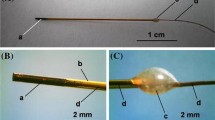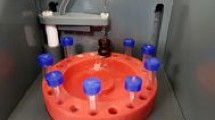Abstract
Conventional high performance capillary electrophoresis (HPCE) detection modes mainly rely on chromogenic, fluorogenic, ionizable, or redox properties of analytes, greatly limiting the scope of analysis. Therefore, the development of a universal HPCE detection system has raised great attention. Herein, by tandem connection of different diameter capillaries (TCDDC), a novel and universal HPCE detection system called interface-induced current detector (IICRD) was constructed. The current signal peaks of analytes in the current-electrophoretograms (CR-EGs) can be observed for the first time. The results of detector performance tests showed good repeatability and high sensitivity. The theoretical deduction and experimental verification were further carried out. To prove the detection ability, several substances with or without special responsive groups were qualitatively and quantitatively analyzed. Firstly, cations and anions in inorganic electrolytes (inorganic salts, acids and alkalis) can be simultaneously separated and analyzed. Furthermore, several small molecular weight organic compounds, monosaccharides and disaccharides were also analyzed. The current signal peaks in CR-EGs were identified and discussed. For quantitative analysis, system suitability tests were evaluated, the results of quantitative analysis methodology validation showed that the new method was qualified for quantitative analysis. The linear relationship between the values of current intensity and the concentrations of analytes can be obtained over the investigated concentration ranges. In summary, the HPCE-DAD-IICRD system showed lower baseline noise, higher sensitivity and higher S/N especially for samples without special responsive groups, showing complementary advantages when combined with other detectors. It is expected to be a novel HPCE detection system for extensive applications.
Graphical Abstract






Similar content being viewed by others
Data Availability
The data that support the findings of this study is available from the corresponding author upon reasonable request.
References
Voeten R, Ventouri IK, Haselberg R, Somsen GW (2018) Capillary electrophoresis: trends and recent advances. Anal Chem 90:1464–1481
Kartsova LA, Makeeva DV, Bessonova EA (2020) Current status of capillary electrophoresis. J Anal Chem 75:1497–1513
Orlet JD, Bailey RC (2020) Silicon photonic microring resonator arrays as a universal detector for capillary electrophoresis. Anal Chem 92:2331–2338
Josefsson L, Goodall D, Emmer S (2020) Implementation of an ultraviolet area imaging detector for analysis of polyvinyl alcohol microbubbles by capillary electrophoresis. J Chromatogr A 1619:460899
Bui DA, Hauser PC (2015) Absorbance detector for capillary electrophoresis based on light-emitting diodes and photodiodes for the deep-ultraviolet range. J Chromatogr A 1421:203–208
Lorenzoa MP, Valientea L, Buendiab I, Gortázarb AR, Garciaa A (2020) Optimization and validation of a chiral CE-LIF method for quantitation of aspartate, glutamate and serine in murine osteocytic and osteoblastic cells. J Chromatogr B 1152:122259
Kammeijer GSM, Nouta J, de la Rosette J, de Reijke TM, Wuhrer M (2018) An in-depth glycosylation assay for urinary prostate-specific antigen. Anal Chem 90:4414–4421
Khatri K, Klein JA, Haserick JR, Leon DR, Costello CE, McComb ME, Zaia J (2017) Microfluidic capillary electrophoresis-mass spectrometry for analysis of monosaccharides, oligosaccharides, and glycopeptides. Anal Chem 89:6645–6655
Comi TJ, Makurath MA, Philip MC, Rubakhin SS, Sweedler JV (2017) MALDI MS guided liquid microjunction extraction for capillary electrophoresis-electrospray ionization MS analysis of single pancreatic islet cells. Anal Chem 89:7765–7772
Kristoff CJ, Li C, Li P, Holland LA (2020) Low flow voltage free interface for capillary electrophoresis and mass spectrometry driven by vibrating sharp-edge spray ionization. Anal Chem 92:3006–3013
Diekmann J, Adams KL, Klunder GL, Evans L, Steele P, Vogt C, Herberg JL (2011) Portable microcoil NMR detection coupled to capillary electrophoresis. Anal Chem 83:1328–1335
Zhang R, Lu S, Zhang L, Zhang G (2014) Assembly of graphene and nickel nanoparticles on anion exchange resin microspheres for the amperometric detection of carbohydrates in combination with capillary electrophoresis. J Chromatogr A 1374:261–267
Yaroshenko I, Kirsanov D, Kartsova L, Sidorova A, Borisova I, Legin A (2015) Determination of urine ionic composition with potentiometric multisensor system. Talanta 131:556–561
Santana MA, do Lago CL (2021) Indirect calibration for capillary electrophoresis with conductivity detection. Anal Chim Acta 1158:338397
Tůma P (2021) Determination of amino acids by capillary and microchip electrophoresis with contactless conductivity detection - theory, instrumentation and applications. Talanta 224:121922
Wang C, Xing H, Zheng B, Yuan H, Xiao D (2020) Simulation and experimental study on doubled-Input capacitively coupled contactless conductivity detection of capillary electrophoresis. Sci Rep 10:7944
Hows MEP, Perrett D (1996) A technique for capillary joining in capillary electrophoresis. Chromatographia 43:200–204
Pavlíek V, Tma P, Matějková J, Samcová E (2014) Very fast electrophoretic determination of creatinine and uric acid in human urine using a combination of two capillaries with different internal diameters. Electrophoresis 35:956–961
Šebestová A, Petr J (2017) Fast separation of enantiomers by capillary electrophoresis using a combination of two capillaries with different internal diameters. Electrophoresis 38:3124–3129
Horka M, Karásek P, Roth M, Šlais K (2017) Fused silica capillaries with two segments of different internal diameters and inner surface roughnesses prepared by etching with supercritical water and used for volume coupling electrophoresis. Electrophoresis 38:1260–1267
Rasmussen HT, Mcnair HM (1990) Influence of buffer concentration, capillary internal diameter and forced convection on resolution in capillary zone electrophoresis. J Chromatogr A 516:223–231
Acknowledgements
This work was supported by the National Natural Science Foundation of China [Grant numbers 81673392]. We appreciate professor Suodi Zhai from Peking University Third Hospital, and professor Weihua Yue from Peking University Sixth Hospital for the support in the experimental instrument.
Funding
This study was funded by the National Natural Science Foundation of China [grant number 81673392].
Author information
Authors and Affiliations
Contributions
TH and CL contributed equally to this work and should be considered co-first authors. XL conceived this research. TH and CL designed the experiments. TH, CL, JL and JX performed the experiments. TH and CL analyzed the data and wrote the manuscript. LG, KZ, XY, YQ and XH took part in some of the experiments.
Corresponding author
Ethics declarations
Conflict of interest
All contributing authors declare no conflict of interest.
Additional information
Publisher's Note
Springer Nature remains neutral with regard to jurisdictional claims in published maps and institutional affiliations.
Supplementary Information
Below is the link to the electronic supplementary material.
Rights and permissions
Springer Nature or its licensor (e.g. a society or other partner) holds exclusive rights to this article under a publishing agreement with the author(s) or other rightsholder(s); author self-archiving of the accepted manuscript version of this article is solely governed by the terms of such publishing agreement and applicable law.
About this article
Cite this article
Huang, T., Liang, C., Li, J. et al. Construction and Application of a Novel Universal Detection System for High Performance Capillary Electrophoresis. Chromatographia 87, 325–337 (2024). https://doi.org/10.1007/s10337-024-04320-4
Received:
Revised:
Accepted:
Published:
Issue Date:
DOI: https://doi.org/10.1007/s10337-024-04320-4




